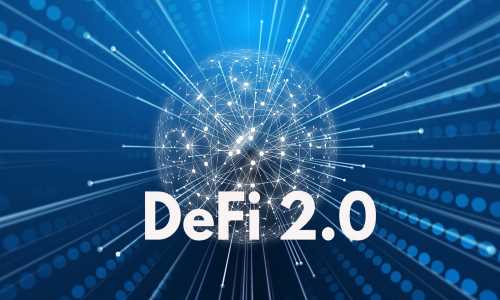What is DeFi 2.0?
 By
By
The first generation of DeFi protocols introduced a slew of novel possibilities. The next version is referred to as "defi 2.0."
What is DeFi 2.0?
Decentralized finance (DeFi) seeks to address traditional finance's flaws, such as excessive centralization and a lack of individual autonomy and property.
To keep things simple, let's call this DeFi 1.0. Decentralized components include an exchange, yield farming, DAO governance, lending platforms, and payment processors.
DeFi 2.0 discusses the several changes made to the DeFi summer 2020 enhancements over the past year. Aave and Uniswap were among the first to launch the DeFi campaign. Many people now have access to financial services that they did not previously have. This has significantly improved their standard of living.
What are the limitations of DeFi?
Embracing new technologies comes with some hazards. DeFi 1.0 has a number of flaws.
Liquidity providers in defi solution may lose money when the prices of each coin fluctuate (LP).
In a decentralized system, no one is in charge of security issues, so if your money is stolen or a smart contract fails, there is no way to fix it. Many people invest in smart contracts without understanding the hazards.
Fewer-known cryptocurrencies have less or less constant liquidity than more popular cryptocurrencies, and their currencies aren't always straightforward to trade due to differences in blockchains. You may need to use more than one platform or be willing to accept slippage losses when trading low-liquidity assets.
Why does DeFi 2.0 matter?
Upgraded DeFi is a one-stop shop for all of your financial needs. MakerDAO in DeFi can be used as collateral for stable currencies and low-volatility assets. Platforms for derivatives generate tokenized assets in a fictitious manner. The method of producing secure indexes. Security flaws never occur on the most secure platforms due to carelessness. defi solution 2.0 fixes issues that existed in the previous version.
DeFi 2.0 is extremely useful in these scenarios. Here are some of its advantages:
Unlike DeFi, the most recent form of decentralized finance does not rely on stable currencies for transactions. DAO is capable of adapting to new technology. Decentralized reserves and assets that can be transported from one location to another are examples of free-floating assets. DAO 2.0 renders stable currency obsolete by inventing new methods of earning money.
DeFi 2.0's purpose is to make money utilization more efficient. It can assist you in locating insurance against the risk of liquidation associated with smart contracts. The defi development 2.0 version is robust. A protocol-controlled liquidity pool (PCL), such as those employed by Avalanche and polygon, comes in handy here. Customers' money is reinvested in the company and distributed to the owners.
DeFi 2.0 makes the financial industry more accessible without eliminating existing dangers. DeFi 2.0 intends to address all of these issues in order to improve the user experience. When incentives are raised, everyone benefits.
Unlocking the value of staked funds
Token pairings that invested in a liquidity pool were compensated with LP tokens. On DeFi 1.0, you can gamble and earn extra money by using LP tokens. DeFi 2.0's value extraction is complete. Millions of dollars are held in safes, making them liquid, but how the money is used may be improved.
DeFi 2.0's security is provided using LP tokens. MakerDAO-style token sales and bitcoin loans are two examples of potential applications (DAI). You should be able to observe the value of your LP tokens while still collecting APY, allowing you to capitalize on new possibilities.
Due diligence on smart contracts can be difficult if you don't know how to code. This data is critical for determining how effectively a project performed. As a result, DeFi initiatives may be detrimental. DeFi 2.0 enables defi smart contract development to get insurance coverage.
Assume you staked LP tokens in a yield optimizer smart contract. If the smart contract is breached, all deposits are at risk of being lost. You can acquire insurance to cover the money you put down on your produce farm for a charge. Concerning only one digital agreement. When a liquidity pool contract is breached, the majority of the time a loss occurs. You may be able to obtain money if the produce farm contract is covered by the insurance policy.
Smart contract insurance
It can be difficult to conduct due diligence on smart contracts if you don't know how to code. This information is critical for determining the quality of a project. Attempting to break DeFi in this manner can be detrimental. DeFi 2.0 enables smart contracts to get insurance coverage.
Assume you staked LP tokens in a yield optimizer smart contract. If the smart contract is breached, all deposits are at risk of being lost. You can acquire insurance to cover the money you put down on your produce farm for a charge. Concerning only one digital agreement. When a liquidity pool contract is breached, the majority of the time a loss occurs. You may be able to obtain money if the produce farm contract is covered by the insurance policy.
Impermanent loss insurance
If you invest in a liquidity pool and begin mining liquidity, you could lose money if the price ratio of the two tokens you locked changes. The newer DeFi 2.0 protocols account for data loss.
Instead of two tokens, a single token can be added to a one-sided LP. The protocol includes a native token for pairing. Finally, the monies that were swapped will be distributed to both you and the protocol.
The approach gradually builds up an insurance fund to cover your deposit by collecting fees. If there are insufficient fees, the system can generate new tokens. Extra tokens can be disposed of by burning or storing them.
Self-repaying loans
Borrowing money is expensive, and if you don't pay it back, you could lose everything. DeFi 2.0, on the other hand, has the potential to change the situation. Consider a $100 cryptocurrency loan. In exchange for $50 in collateral, the lender will provide $100 in cryptocurrency. Lenders will charge you interest while repaying the loan with your down payment. The lender will return the money you gave them once they have made $100 and paid their charge. There is no imminent threat of bankruptcy. When the collateral token's value falls, the loan payment is postponed.
Who's in control of DeFi 2.0?
Who is in charge of overseeing the operation of so many distinct services and programs? Blockchain was designed from the start with decentralization in mind. The same as DeFi. MakerDAO (DAI) was the first decentralized finance development company project in DeFi 1.0, and it established a precedent. People in the community now have a voice in numerous programs.
Tokens can be used to vote and pay for items on multiple platforms. DeFi 2.0 has the potential to spread influence in the business sector. Regulators and compliance needs will soon take precedence over DeFi.
What are the risks of Defi 2.0, and how to prevent them?
Many of the issues that plagued DeFi 1.0 remain in DeFi 2.0. These are some of the most dangerous risks and how to avoid them.
For starters, there's always the possibility that the smart contracts you're employing have weaknesses, backdoors, or hackers that could harm your firm. There is no such thing as a project safety audit. You should learn everything you can about the problem and the hazards associated with it.
Investment decisions are influenced by regulations. The entire world has been told that the DeFi ecosystem is a fascinating subject. The bitcoin business can grow more stable and safe for legal and regulatory reasons, but some projects may need to adjust their services to fit.
It may be difficult to obtain financing. When you stake through a defi development company project's online interface, you can utilize a blockchain explorer to locate the smart contract. Withdrawals are not possible if you are unable to access the website. Using a smart contract is a technical undertaking that demands its users to be knowledgeable.
Closing thoughts
Despite the fact that DeFi initiatives have had a lot of success, DeFi 2.0 has just scratched the surface of its possibilities. Most individuals don't comprehend the subject, and no one should pay money on something they don't understand. The process should be simplified, especially for first-time users. There have been novel approaches to reduce risk while increasing APY, but defi development services will only work if it achieves what it promises.






